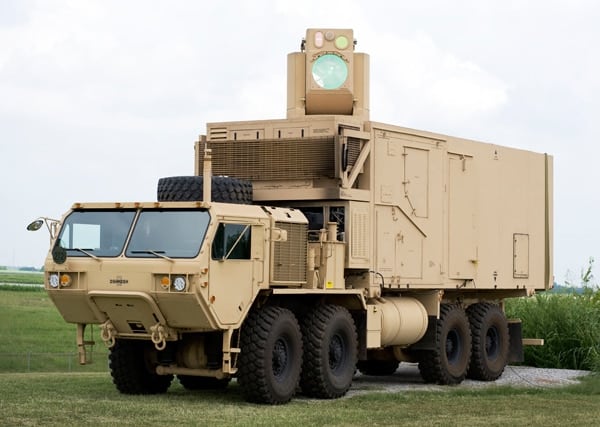The U.S. military is set to see a 51 percent increase in funding to develop and procure laser weapons, a technologically-advanced "game-changer" as troops prepare for new and growing asymmetric threats around the world.
The 2017 defense bill signed last week by President Obama authorized roughly $328 million for the development and procurement of these weapons. That's a 51 percent increase from 2016 spending levels. Lawmakers cited the progress made by the Defense Department as a key reason for the boost.
"The Department of Defense has made significant advances in the development and operational demonstration of directed-energy weapons systems," according to the bill. "Each military department has demonstrated a marquee program in this area, such as the Navy's Laser Weapon System (LaWS) deployed on the USS Ponce, the Army High Energy Laser Mobile Demonstrator (HEL-MD), and the Marine Corps' Ground Based Air Defense System (GBAD)."
Laser weapons continue "to offer promise as a transformational 'game changer' as the DoD encounters new asymmetric and disruptive threats while facing increasingly sophisticated traditional challenges," a government task forceon directed-energy weapons reported.
And the need for mobile ground-based air defense systems for ground forces goes beyond the increasing technological capabilities of Russia and China. It also targets the growing threat and proliferation of drone use by terrorist and non-state actor groups.
Just this October, U.S. troops were faced with threats of exploding dronesoperated by ISIS fighters besieged in Mosul; and in August, video surfaced of attack dronesbeing operated by the Iranian proxy militia, Hezbollah in Syria.
To prepare for the growing challenges faced by U.S. forces, such as the proliferation of drone technology, ballistic missile systems and small boat threats to U.S. and allied vessels, each military service is developing laser weapon systems.
With U.S. forces operating in highly dense civilian populations, the ability to discriminate enemy targets becomes a must, and "laser systems enable precision ground attack to minimize collateral damage in urban conflicts and in close proximity to friendly troops," the Defense Task Force on Directed Energy Weapons reported.
Laser weapon systems also have advantages over conventional munitions. Because lasers fire at the speed of light, enemy targets can't avoid it. Lasers make no sound when fired and can't be seen with the naked eye, allowing the operator of the weapon system to remain concealed through out the operation.
Despite the costs of research to develop directed-energy weapons, once completed, the cost to fire a single round will be reduced to the energy it produces. This also simplifies logistics chains, allows ships to remain at sea for longer duration, and limits the amount of ground and air resupply operations to ground forces. In the long run, that also translates into reduced costs for expeditionary forces, as the need to store and maintain heavy dangerous explosive ordinance is lowered.
In December 2014, the Navy successfully tested its LaWS system against a series of small boats and drone aircraft. Shortly thereafter, that system was declared operational for use in the Persian Gulf, with future plans to mount the system on the Navy’s Zumwalt destroyer.

The High Energy Laser Mobile Demonstrator, or HEL MD, is the result of U.S. Army Space and Missile Defense Command research.
Photo Credit: Eric Shindelbower/Army
The Army’s HEL-MD, or smaller truck mounted version the High Energy Mobile Laser Test Truck, is still undergoing testing. As of 2014, the HEL-MD successfully shot down a 22- to 55-pound Class 2 drone during a test at the High Energy Laser Systems Test Facility at White Sands Missile Range, New Mexico.
The Marines’ variant of the HEL-MD is the GBAD, a laser defense system designed to shoot down incoming enemy drones and aircraft. Currently, the program is entering phase two out of three phases — graduating from firing a 30-kilowatt laser while immobile to firing while on the go. The program is expected to be completed by 2022.
Also included in the defense legislation is a provision requiring the Pentagon to designate a senior official within the Defense Department "as the official with principal responsibility for the development and demonstration of directed energy weapons for the Department," the bill stipulates.
The bill also sets aside $25 million for bilateral cooperation with Israel on the development and procurement of directed-energy weapons systems designed to detect and defeat ballistic or cruise missiles, upon the signing of a memorandum of agreement between the two countries.
The increase in spending in the National Defense Authorization Act for fiscal year 2017 on laser weapon research and procurement highlights that Congress is getting more serious about the need for directed-energy weapons, while also recognizing the advances the defense industry has made in the development of the futuristic weapon.
However, the authorization bill sets defense policy and spending priorities for the current fiscal year. It does not actually assign the money for those initiatives. The appropriations process, which distributes the money, has been stalled on Capitol Hill for months.
Shawn Snow is the senior reporter for Marine Corps Times and a Marine Corps veteran.





